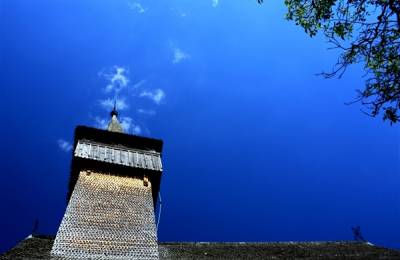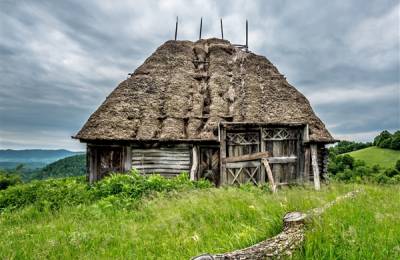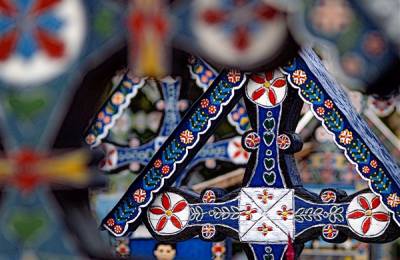Description
Maramures is a fairy tale area, but this is not a secret for anybody, whether you have been there, you have friendsor you have just seen pictures. Maramures County is one of the northernmost provinces of Romania and may be located on a map between the parallels of 47o20'00" and 48o00'15" North latitude and the meridians of 22o52'30" and 25o07'30" East longitude. Maramureş covers an area of 6304 km2.
In the North the river Tisa and the ridge of the Maramures Mountains make up the county's natural border with Ukraine. To the East, over the Prislop Pass stretches the historical province of Moldavia (Suceava county). To the south-east, beyond the Rodna Mountains, there is Bistrita-Nasaud county, with the legendary abode of Count Dracula. The counties of Cluj and Salaj lie to the South and the flatland of Satu Mare county extend to the West up to the Hungarian border.
Attractions
Cock’s Cumb
The Creasta Cocosului Natural Reservation is located in Gutai Mountains at 1.4000 meter altitude, about 30 km from the cities Baia Mare and Baia Sprie of Maramureş Conuty. The name of this true natural jewel come from the similarity between the mountain ridge and the comb of a cock. The relief, composed of volcanic rocks, has a unique look: especially in the Mara Valley. The Creasta Cocoșului Natural Reservation covers an area of only 50 hectars and has an average altitude of 1200 m. The highest point of the ridge reaches a height of 1450 m. The relief was than carved by the raine and wind by torrents getting to this unique forme from nowadays. Creasta Cocosului can bee seen from a great distance from all over Maramures, representing a beloved landmark for tourists and mountaineers. Creasta Cocosului is sought by mountaineers but also by those who practice extreme sports because here you can practice climbing.
Ocna Sugatag Salt Lake
After winding roads passing through green forests and lovely villages, where every colorfoul household seems a museum itself, less than 20 km from Sighetu Marmatiei, on DN18 you enter the little town Ocna Sugatatg. After you come back to your senses from your reverie it is time to seek the destinations offered by this small town and for this purpose the salt lakes of Ocna Sugatag are a true jewel of Maramures. Due to the salt explotation mines that operate here but wich collapsed in time and to the mineral sring that traverse the lands the water was able to find beds in order to form salt water spots including Gabriel lake unique in Europe. If you look at pictures with Gabriel Lake you will be a little confused, because altough it is a lake with high salt concentrations you will see tourist with the fishing rod. How is this possible? It is simple, another wonder of the nature, above the lake being a fresh water film fed by the surroundings springs making the aquatic life possible.
Firiza Lake
Firiza is the name of a reservoir located near Baia Mare whici attracts annually a lot of passionate fishermen, but not only. Located slightly above the village Izvoarelor, in Firiza town, the lake with the same name. Presently the lake has a length of 3 km and a width of 1 km. The main attraction is fishing. Trout, catfish and bream are only three species of fish that cand be found on Firiza lake. But note that the fishing is only alowded in the period May 1st to October 10.th and you will also need approval. Fishing tickets, but also boats to rent can be found at the guesthouses nearby.
The Art Museum. Baia Mare
If you are on a trip to Maramures try not to miss the Art Museum from Baia Mare located a few hundred meters from the old center. Since the nineteenth century in Baia Mare there has existed an art colony on the model of the ones in France, England, Switzerland etc. Because of this intense artistic activity in the city. Baia Mare were recognized as the city of the painters in Europe. If you go to visit you can see over 3.300 pieces, representing the European art of the past centuries, but also the modern one.
Săpânța Merry Cemetery
Săpânța is an interesting village from Maramureș located just 4 kilometres south of the Ukrainian border. Is world-famous for its original "Merry Cemetery": a special kind of graveyard, with wooden crosses painted in vivid colors. A particular blue, called „Sapanta blue" rules over all the other colors. The author of this cemetery is Stan Ioan Pătraș. He carved the first cross in 1935. He died in 1977 and his creation was continued to this day and carried on by Patras's apprentice, Dumitu Pop. You have to know that every cross is different: the carved images naively catch one of the deceased lifetime's characteristic attitudes, while the epitaphs are short poems, deprived of the usual cliches and full of substance, written in the first person like a confession of the deceased himself. Most of them are very funny perhaps that is why it is named merry cemetery.










